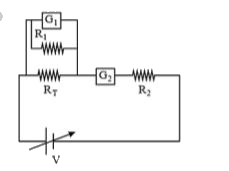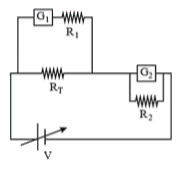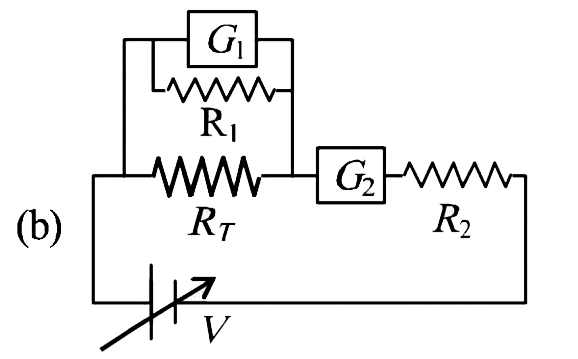To verify Ohm's law, a student is provided with a test resistor R1 a high resistance R2 , a small resistance R two identical galvanometers G1 and G2, and a variable voltage source V. The correct circuit to carry out the experiment is:




The correct Answer is:C
G1 is used as a voltmeter by connecting it in series with high resistance R1 and connected it cross R1 in parallel and G2 is used as an ammeter by connecting it in parallel with small resistance R2 (called shunt) and connected in series with R1 as shown in the figure.
Hence, above circuit is used to verify Ohm.s law.
Similar Questions
To verify Ohm's law, a student is provided with a test resistor RT, a high resistance R1 . a small resistance R2, two identical galvometers G1 and G2 and voltage source V. The correct circuit to carry out the experiment is.
View SolutionTo verify Ohm's law, a student is provided with a test resistor RT, a high resistance R1 . a small resistance R2, two identical galvometers G1 and G2 and voltage source V. The correct circuit to carry out the experiment is.
View Solution
Knowledge Check
To verify Ohm's law, a student is provided with a test resistor RT, a high resistance R1, a small resistance R2, two identical galvanometer G1andG2, and a variable voltage source V. The correct circuit to carry out the experiment is
A B
B C
C D
D
To verify Ohm's law, a student is provided with a test resistor RT, a high resistance R1, a small resistance R2, two identical galvanometer G1andG2, and a variable voltage source V. The correct circuit to carry out the experiment is
A B
B C
C D
D
If G,rA and rV denote the internal resistances of a galvanometer, an ammeter and a voltmeter among the following the correct relationship is
AG<rA<rVBrA<rV<GCrA<G<rVDrV<rA<G
You are provided with one low resistance R1 and one high resistance RH, and two galvanometers. One galvanometer is to be converted to an ammeter and the other to a voltmeter. Show how you will do this with the help of simple, labelled diagrams.
View SolutionIn the curcuit given below D1 and D2 are two identicall diodes and V is a sinusoidal voltage source the voltage drop across the resistance RL

View SolutionConsider two identical galvanometers and two identical resistors with resistance R. If the internal resistance of the galvanometers Rc<R/2, which of the following statement(s) about any one of the galvanometers is (are) true?
View SolutionIf G, rA and rV denote the internal resistances of a galvanometer, an ammeter and a voltmeter among the following the correct relationship is
View SolutionConsider two identical galvanometers and two identical resistors with resistance R. If the internal resistance of the galvanometers Rc<R/2, which of the following statement(s) about any one of the galvanometers is (are) true?
View Solution
